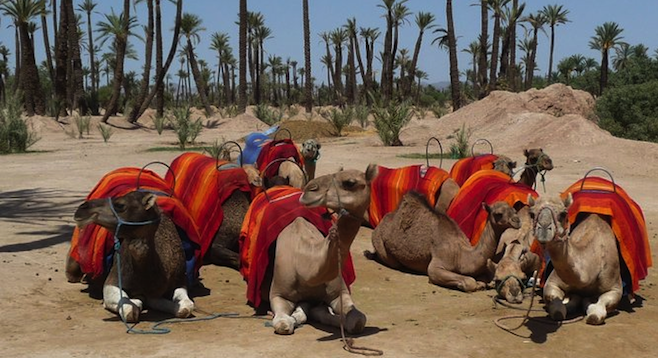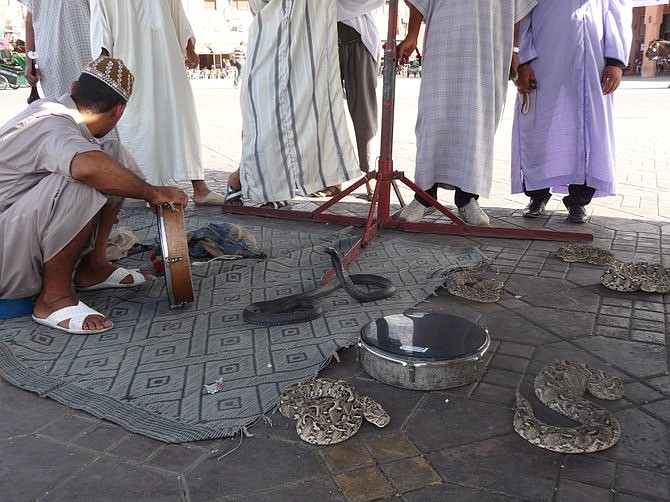 Facebook
Facebook
 X
X
 Instagram
Instagram
 TikTok
TikTok
 Youtube
Youtube

Our first excursion in Marrakesh was to find the medina where all the souks (shops) were located.
Moroccan taxi drivers are on the fast pass to meet Allah. No wonder they have a call to prayer five times a day. You have cars, swarms of taxis, helmetless motorbike and moped riders – some with geese and peacocks tied down in their moped basket – horse and carriages, mules schlepping carts of produce and bicycles all sharing the same road.
Road markers are clearly just a suggestion. If you feel that you're not making significant progress you can make your own lane, as well as drive within an inch of other moving metal objects. And don’t forget to announce yourself every five seconds with your horn. I even witnessed five rollerbladers holding onto the fender of a car rolling down the street.
Our introduction to the medina was a sensory overload. In the open plaza, Jemaa el-Fnaa, one of the busiest squares in the world, you have all forms of street entertainment, including drum circles, magicians, a guy with a monkey that you can have your picture taken with, women who want to tattoo your hands with henna (which is more like magic marker), bands, and a tooth puller. I still can’t figure out what I’d do with someone else’s teeth.

I did pay to have my picture taken with the snake charmer (left) with flute and his fangless, rattleless snakes. Beware that the picture taker will try to squeeze you for far more than you’ll want to pay.
The center of the plaza has aisles of fresh squeezed orange juice for about fifty cents a glass as well as local food cooking in different stalls. The souks are very similar to shopping in Tijuana where the venders call out to you and invite you into their shop. Expect to bargain as well.
To avoid any further life-threatening taxi rides, we bought a ticket on the hop-on/hop-off bus to tour the sites in Marrakesh. We visited the Palais Bahia, a great example of Muslim architecture with beautiful mosaic ceilings, and the ruins of Palais Badi, with stork nests built on the tops of the walls. The walls of the palace were built with holes like Swiss cheese so the clay doesn’t crack.
Beware of helpful men offering assistance. A man told us about a “free museum” that turned out to be a rug shop. The salesman offered us glasses of mint tea and rolled out about ten rugs, showing us all the different kinds and how some are reversible. The smallest one he had was about $250; bigger rugs sell for $2500 and can take up to two years to make.
Camel rides are also available for rent outside the city (top).
Eating in a foreign country is always an adventure. We tried to eat only local, “authentic” food in Morocco. Warning: this may also cause gastronomic and intestinal revolt. We were told to only drink bottled water, as the mineral content in tap water is high.
We had tagine, a spicy stew of meat (chicken, beef or lamb) and vegetables simmered for hours with spices in a clay pot, almost every day, as well as kefta, spicy meatballs cooked with egg. A popular delicacy in Morocco is pastilla, made by layering thin pieces of flakey dough between sweet, spiced meat filling and layers of almond paste filling, baked and coated with powdered sugar. And of course, couscous is a Moroccan staple.
One of the things we had to get used to pretty quickly is that service is extremely slow by American standards, and you have to ask for your bill. Nobody has change for larger bills either.


Our first excursion in Marrakesh was to find the medina where all the souks (shops) were located.
Moroccan taxi drivers are on the fast pass to meet Allah. No wonder they have a call to prayer five times a day. You have cars, swarms of taxis, helmetless motorbike and moped riders – some with geese and peacocks tied down in their moped basket – horse and carriages, mules schlepping carts of produce and bicycles all sharing the same road.
Road markers are clearly just a suggestion. If you feel that you're not making significant progress you can make your own lane, as well as drive within an inch of other moving metal objects. And don’t forget to announce yourself every five seconds with your horn. I even witnessed five rollerbladers holding onto the fender of a car rolling down the street.
Our introduction to the medina was a sensory overload. In the open plaza, Jemaa el-Fnaa, one of the busiest squares in the world, you have all forms of street entertainment, including drum circles, magicians, a guy with a monkey that you can have your picture taken with, women who want to tattoo your hands with henna (which is more like magic marker), bands, and a tooth puller. I still can’t figure out what I’d do with someone else’s teeth.

I did pay to have my picture taken with the snake charmer (left) with flute and his fangless, rattleless snakes. Beware that the picture taker will try to squeeze you for far more than you’ll want to pay.
The center of the plaza has aisles of fresh squeezed orange juice for about fifty cents a glass as well as local food cooking in different stalls. The souks are very similar to shopping in Tijuana where the venders call out to you and invite you into their shop. Expect to bargain as well.
To avoid any further life-threatening taxi rides, we bought a ticket on the hop-on/hop-off bus to tour the sites in Marrakesh. We visited the Palais Bahia, a great example of Muslim architecture with beautiful mosaic ceilings, and the ruins of Palais Badi, with stork nests built on the tops of the walls. The walls of the palace were built with holes like Swiss cheese so the clay doesn’t crack.
Beware of helpful men offering assistance. A man told us about a “free museum” that turned out to be a rug shop. The salesman offered us glasses of mint tea and rolled out about ten rugs, showing us all the different kinds and how some are reversible. The smallest one he had was about $250; bigger rugs sell for $2500 and can take up to two years to make.
Camel rides are also available for rent outside the city (top).
Eating in a foreign country is always an adventure. We tried to eat only local, “authentic” food in Morocco. Warning: this may also cause gastronomic and intestinal revolt. We were told to only drink bottled water, as the mineral content in tap water is high.
We had tagine, a spicy stew of meat (chicken, beef or lamb) and vegetables simmered for hours with spices in a clay pot, almost every day, as well as kefta, spicy meatballs cooked with egg. A popular delicacy in Morocco is pastilla, made by layering thin pieces of flakey dough between sweet, spiced meat filling and layers of almond paste filling, baked and coated with powdered sugar. And of course, couscous is a Moroccan staple.
One of the things we had to get used to pretty quickly is that service is extremely slow by American standards, and you have to ask for your bill. Nobody has change for larger bills either.
Comments